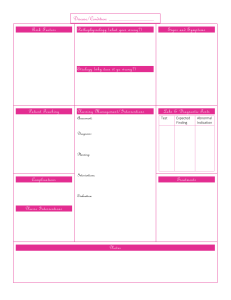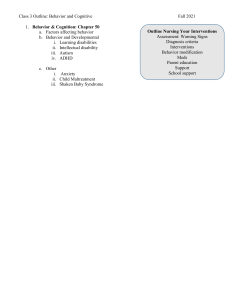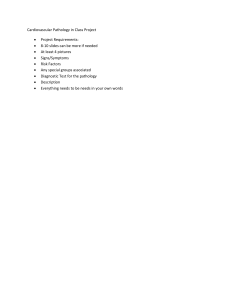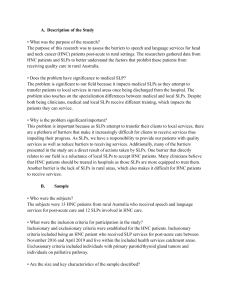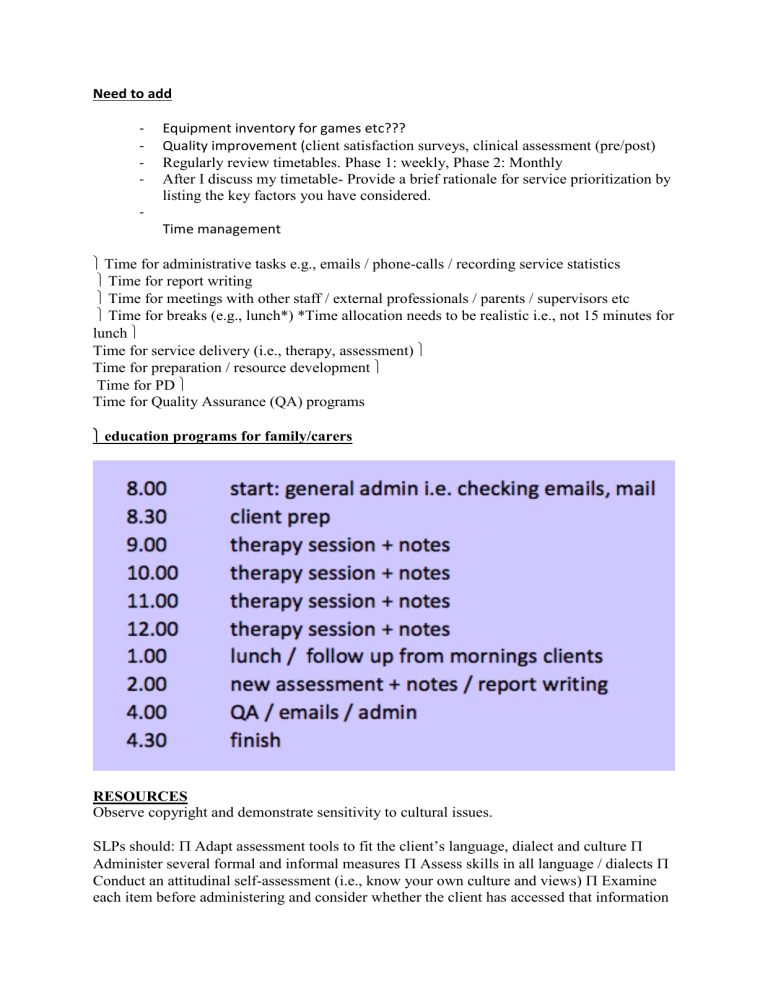
Need to add - Equipment inventory for games etc??? Quality improvement (client satisfaction surveys, clinical assessment (pre/post) Regularly review timetables. Phase 1: weekly, Phase 2: Monthly After I discuss my timetable- Provide a brief rationale for service prioritization by listing the key factors you have considered. Time management Time for administrative tasks e.g., emails / phone-calls / recording service statistics Time for report writing Time for meetings with other staff / external professionals / parents / supervisors etc Time for breaks (e.g., lunch*) *Time allocation needs to be realistic i.e., not 15 minutes for lunch Time for service delivery (i.e., therapy, assessment) Time for preparation / resource development Time for PD Time for Quality Assurance (QA) programs education programs for family/carers RESOURCES Observe copyright and demonstrate sensitivity to cultural issues. SLPs should: Adapt assessment tools to fit the client’s language, dialect and culture Administer several formal and informal measures Assess skills in all language / dialects Conduct an attitudinal self-assessment (i.e., know your own culture and views) Examine each item before administering and consider whether the client has accessed that information and if failure should be considered a disorder Observe whether the disorder exists in both languages Report norms only if they are valid for the population being assessed Observe code switching and the influence of one language on another Ask families to complete forms/documents in person Roles of me for cultural issues Areas of testing, e.g.: Tests in English Oro-motor Non-verbal assessments Family interview… Ask for help Be client’s advocate Do research on culture/linguistics Refer Use least-biased assessments Establish contacts (SPA website – bilingual SLPs) Establish networks… RESOURCES Identify local procedures to access resources. Develop knowledge of where or with whom resources are held on site. • Ask your senior – finance department • Grants • Charity / community organisations • Is borrowing / sharing resources an option? Public libraries e NEED TO MAKE EQUIPMENT INVENTORY LIST 1. Routinely use scientific principles in clinical assessment, planning and evaluation of intervention and in the development of educational materials. 2. Critically evaluate evidence from literature and research using knowledge of research methods and statistics. Cues for this element: Knowledge of scientific principles: • using available evidence-based practice resources to determine efficacy of work practices (e.g. speechBITE™ or The Cochrane Library) • accessing through library the electronic databases relevant to speech pathology work practices • collecting data systematically and thoroughly in accordance with service protocols for measuring outcomes • participating in collaborative clinical research with senior speech pathologists (e.g. single case designs; clinical pathway mapping). speechBITE™: Speech Pathology Database for Best Interventions and Treatment Efficacy • Free searchable database available on the internet that gives you access to the best evidence across all areas of speech pathology intervention. • http://speechbite.com/ 2. Cochrane Library http://www.cochranelibrary.com/ Collection of data can facilitate: • Clinical benchmarking • Workload management • Accountability • Measuring outcomes • Effective management of human and material resources Outcomes are important because they help us to… demonstrate the quality of a service document progress - show change in individual patients over time, monitor progress towards individual goals be accountable reflect on our clinical reasoning and service provision set future goals/ plan therapy / recognise when a different approach is needed Knowing which outcomes are important to a client also informs goal setting “begin at the end” 1. Performance based instruments- IMPROVING SCHOOL READINESS? Eg. measures of lang function 2. Client reported outcome measures- Family quality of life 3. Education of educators? Focus on the Outcomes of Communication Under Six RESOURCES ● Noah's Ark Resource Library ● Grants – often centre around global services, innovation, start-ups, not-for-profit, home based business ● Assessments – Pearson, psychorp, ACER ● Resources – Silvereye, Fox education, Black sheep resources, Fun stuff, Can be dedicated or not. (i.e. specific resources developed by SLPs, or use of story books/toys/games) ● Interventions as resources – Hanen, Visualising & Verbalising, Boardmaker, PECS, DIR Floortime, PLD literacy ● Electronic – benefits/disadvantages of iPad based resources ● Free resources – Caroline Bowen website, pintrest, superteacher etc – BUT beware of using a 'resource' without an intervention approach! - also beware of using toys without explaining interventions (!) “They just played with them…” ● Process: What are the client's needs? What does the evidence say? What resources will provide an opportunity to deliver the evidence based interventions?' How can I make these interventions & resources accessible to parents? Professional groups and services Special interest groups, facebook interest groups, local community groups ● SPA involvement – Private Practice Member Network (Teleconferences & social events) & Qld Branch EVIDENCE ● ASHA Evidence Maps ● Speechbite / Cochrane library / Google scholar ● SPA – evidence practice updates ● Within your practice – clinical pathways?! Do they exist? ● EBP is linking best available evidence WITH clinical judgement AND client needs & values. Interpreter (3 hour): - Involved in assessment process, family discussions, translating written materials if necessary. If not required, this hour will be added for direct contact.
